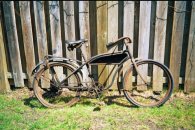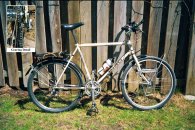John Dowding's Bicycles
Welcome to my bicycle web page. If you want to explore one of my other
interests go to my Home page.
To see bicycle pictures I took during the St. Patrick's Day parade,
click
here.
On this page you can see some of the bikes I've owned or learn about
my history in bicycles, so read on.
Some of My Bikes
Here are some of the bicycles that I have owned, built
or refurbished. (Click on the thumbnails for larger JPEG images)
 |
 |
 |
 |
 |
| Swingbike |
1934 Elgin Blackhawk |
Homemade 42-Speed |
Homemade Touring Bike |
Tech Wild Thing Mountain Bike |
Where It All Started
Bicycles have been a big part of my life since I was
a child. I grew up in the industrial town of Sault Ste. Marie, Canada and
I started working on bikes in the mid 1960's when I was about 6 years old.
My father taught me how to perform many repairs then and I never stopped
looking for more to learn. By the time I was 10, I was building my own
bicycles from scrap parts and since that time, except what I can count
on my two hands, all of the literally hundreds of bikes I've owned in my
life have been built by me. By far the vast majority of my home-made bikes
were what my friends and I called trashmobiles or beaters, bicycles built
for no purpose other than to ride them hard till they broke (we didn't
have mountain bikes then). We rode our bikes along trails in the bushes
and off what we called cliffs, about 6 foot (2 m) drops, only to land and
sometimes have a frame or wheel collapse. No wonder my mother worried so
much! We'd haul the broken pieces back home and toss them in the supply
of parts for future use.
I repaired and overhauled many coaster brake hubs
like CCM and Perry as well as many Sturmey Archer 3-speeds. When I was
in grade 8, I figured out how to put two cogs on a 3-speed or 5-speed internal
hub and this led to many ideas. I quickly figured out that I could get
20 (or 30) speeds on a single bicycle at a time when some people were balking
at the idea of 10 speeds (imagine, who needs 10 speeds anyway?). Before
working on the 20-speed, I built a 12-speed using a high-rise bicycle (high
handlebars, banana seat, 20" wheels) with a 3-speed hub and 2 cogs having
16 and 20 teeth combined with a home-made dual chainring having 24 and
36 teeth. I have only one photo of this bike but it's actually a picture
of my kid brother holding the family cat with my bike in the background.
Few of the bike details can be seen in the photo.
I also designed other gear combinations on paper
and even had a machine shop weld a freewheel body on the driver assembly
of a five speed hub in an attempt to get a hub with 25 speeds (something
similar to SRAM's 3x7 hub but 25 years earlier). This might have worked
except that it was welded on crooked. As the sprockets rotated, the chain
kept riding up and down a couple of them. Hey, it was an experiment that
didn't cost me anything except parts from my junk bins. The welding was
done for free. Another design that never left paper was an exercise in
the absurd that had a total of 400 gears. This bike would have a second
rear hub mounted just under the seat with two 20-speed setups in series.
It would need 2 chains, 4 derailleurs and 8 shift levers. I might still
build this one yet just for the fun of it. It's main drawback is that they
would not all be unique gears unless I replaced one of the two 5-speed
Sturmey-Archer hubs with a 7-speed or some other hub, as long as the two
internal hubs had different sets of gear ratios.
In the fall of 1975, I was riding along and a motorist
suddenly opened the door of his parked car right into my path. Since there
was traffic passing me I had nowhere to swerve and I hit the door, causing
among other things, a bent frame on my bike. Because he was charged for
opening the door without looking, his insurance company gave me a cheque
to pay for my repairs (a new frame and labour). I finally had enough money
to build my 20-speed. For this, I used the cogs from my 12-speed, my Sturmey
Archer 5-speed hub and a double crankset. I also tried to use a home-made
triple crankset but at that time I couldn't find a front derailleur that
had enough travel to work with three. I had to accept 20 speeds, not 30
- oh, well. I built the whole thing on a 221" (53 cm) Chiorda frame (purchased
with the insurance money) along with racing handlebars and 26 x 1 1/4 wheels.
It had 4 shift levers, one for each derailleur and two for the rear hub
and it attracted the attention of anyone who knew anything about bicycles.
I rode that bike for about 5 years till I decided that I wanted something
lighter (it weighed about 35 pounds).
The Bikeshop Years
In 1977, for a summer job, I worked for Cochrane Dunlop
Hardware Store in Sault Ste. Marie for minimun wage of $2.65 an hour. On
my first day on the job, I was asked if I had any experience with Positron
derailleurs. I thought I was being tested to see whether I was good enough
to work in their bicycle department. I quickly found out that I WAS the
bicycle department. The Positron derailleur was giving the sports department
manager some serious problems and he wanted someone to deal with it. For
anyone who has not had the grief of working on one of these, they were
one of Shimano's early attempts at indexed shifting with the click stops
in the derailleur rather than in the shift lever. There were a number of
variations of the setup including one that used a solid cable instead of
the usual stranded gear cable. To shift to a lower gear, the shift lever
pulls on the cable and to shift to a higher gear, the lever pushes on the
cable in order to push the derailleur down to the smaller cogs. To understand
the misery of working on these things, just remember the phrase "you can't
push on a rope".
I worked there for that summer and the first couple
of weeks of the summer of '78 (minimun wage had increased to $2.85/hr.).
I was in university in those years so minimum wage didn't exactly cover
my bills. For the rest of that summer I managed to get a job at Algoma
Steel loading plates and strips of steel onto trucks and trains for almost
4 times the money. I worked in numerous departments at Algoma for the next
few summers then the steel industry suffered a major downturn in the early
'80's. For the summer of 1982, Algoma stopped hiring students and I was
to forced to fall back on my lifelong passion again. This time I got a
job at Bicycle Revival in Ottawa. An actual bicycle shop, not a hardware
store that happened to sell bicycles. I worked there during the summers
till I got my Engineering degree and continued to work part time at that
shop for over a decade. Eventually, the grease and cleaning solvents started
to take their toll on my hands and I stopped working at Bicycle Revival.
That was in the mid '90's and for the following few years I didn't work
in any shop at all. I continued to maintain, repair and build my own bikes
and when my friend Pete Conway (a former manager at Bicycle Revival) acquired
McCrank's Cycles in Ottawa, I started
helping out from time to time, usually working on internally geared or
other 'out of the ordinary' hubs.
To be continued...
Home
This page was last updated March 13, 2005.









